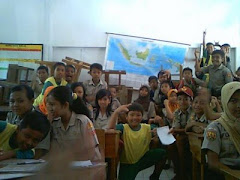
"Semoga tetap bermanfaat walau hanya seorang rakyat biasa"
~Onno W. Purbo, M.Sc., Ph.D.~
1. Wawan Nurwana, S.Pd. (SDN 3 Bangunharja, Universitas Terbuka Indonesia)
2. Tining Sri Wahyu Dewi (My Mother who always give me spirits. Cita-cita kecilnya ingin menjadi seorang guru sekolah dasar)
3. Susi Susilawati (My aunt, Universitas Terbuka Indonesia)
Semua Guru-guru dan teman-temanku ketika taman Kanak-kanak hingga Sekolah Dasar.
Ua Ellah, Ni Lilis, Ua Teti, Ua Kalwan, Ua Ustadz Muhaemin, Ua Tata, Ibu Edah, Ua Ika dan semuanya.
Paman dan bibiku:
Yusuf Kurniawan, S.Pd. & Hikmah, S.Pd.
Bpk. Munir, M.IT., Ph.D.
(Computer Science Lecturer @Universitas Pendidikan Indonesia)
The role and the use of the Information and Communication Technology (ICT) in Learners Support Services in Open and Distance Learning (ODL) is a proven fact now. The distance education system responded positively and quickly to the revolution in ICT.
It is because of three reasons the need to reduce the cost of imparting education, to introduce need based educational programmes to a large number of people and to reduce time required for sanctioning new programmes by adopting new flexible nature of administration.
ICT is a major factor in shaping the new global economy and producing rapid changes in society. Within the past decade, the new ICT tools have fundamentally changed the way people communicate and do business. They have produced significant transformations in industry, agriculture, medicine, business, engineering and other fields. They also have the potential to transform the nature of education where and how learning takes place, and the roles of students and teachers in the learning process.
Embedding ICT in teaching-learning process is a major initiative in all branches of education; ICT has a particularly important role to play in developing provision for bilingual learners. This is concerned with exploring new ways of working with bilingual learners as well as facilitating more established techniques. The increased use of ICT to deliver and enhance aspects of educational provision is now an emerging practice for all learners belonging to rural and geographically remote and mainly monolingual areas thus having advantages in overcoming geographical barriers.
For example video conferencing facilities developed to enable isolated learners to share learning with others in remote areas can also be used to reduce linguistic isolation by allowing same first language learners to discuss and communicate remotely.
Learners Support Services are an important part of Distance Educational system. Since the learners in ODL system are not directly involved in the regular classroom teaching-learning process having direct interaction with the teachers regularly, they are provided with adequate Learners Support Services.
Such support services include the pre-admission counselling, admission process, provision of study materials both in print media and audio visual forms, subject specific academic counselling, audio visual viewing facilities, participation in teleconferencing, ICT facilities for e-learning, library services, laboratory support facilities, academic career guidance, information services related to rules, regulations, procedures, schedules etc.
The role of ICT to speed up the delivery of the support services has now become inevitable for the distant learners. It also considers the shift from mass produced generic resources to tailored, personalised support and communications and sets this in the context of globalisation of the economy and the changing expectations of students as 'consumers.'
ICT and Learner Support
Distance and open education schemes that have until recently relied mainly on the mailing of written materials, videos, cassette recordings, and radio or TV broadcasting techniques can be augmented, enhanced or replaced by new on-line tools and technologies which have the power to transform the learning environment.
Technological developments are coming together which offer the following benefits:
Through the Internet and worldwide web, new and enlarged sources of information and knowledge that offer teachers and students opportunities for self-development as well as benefits from incorporation into classroom environments.
Through e-mail and other Internet related feedback mechanisms, greater opportunity to reduce the isolation and time delay associated with distance education.
Through the extraordinary pace of software development, enriched teaching and learning with enhanced graphics, interaction, animation and visualisation.
Through lowering telecommunications bandwidth costs and emergence of enhanced cable, wireless and satellite systems, greater opportunities for basic access, video conferencing, on-line interactivelearning, and live interaction with the central place of a distance education programme.
Through community access schemes, more potential to make the benefits of distance education eventually available to lower income people and rural communities.
Sound pedagogical principles would increasingly dictate the need for a more interactive learning environment which was earlier difficult to achieve and also adds considerably to the remotest areas. But it was noted that its deployment requires expensive satellite resources as well as an expensive face-to-face lecture and broadcast system running in parallel.
Very Small Aperture Terminal (VSAT) satellite systems are increasingly seen as a powerful distribution mechanism for Internet based resources, with ready access to interactive learning tools and e-mail, especially when linked or packaged with key educational web-site sources, servers and services. VSATs can overcome many of the bandwidth/delivery speed, limitations of terrestrial systems, particularly in developing countries, and can be especially economic when deployed in an asymmetric multi-casting mode in which high-speed 'downlink' capability is combined with slower speed 'uplinking.'
These features and the emerges the need of specially designed Distance Education network management and learner software packages of ICTs in distance education especially in the developing world.
The use of ICT in distance education actually depends on at least five factors.
These are:
These are:
Geographical size and situation: Large countries with dispersed people and communities have an additional drive or motivation to use communications to deliver educational services cost-effectively.
Policy on Telecommunications:
The Internet, IT and Education, Privatisation and Liberalisation of telecommunications and the Internet are improving quality, lowering costs and accelerating innovation around the world. Education policy is often the key to raising awareness and providing leadership in educational use of ICTs.
The Internet, IT and Education, Privatisation and Liberalisation of telecommunications and the Internet are improving quality, lowering costs and accelerating innovation around the world. Education policy is often the key to raising awareness and providing leadership in educational use of ICTs.
Population and market size: Small markets attract fewer investors and less competition, and offer fewer economies of scale which would lead to price reduction, while regional schemes can overcome that, aggregate market size and achieve scale economies.
Per Capita Means:
To address start-up investment challenges and the market affordability to attract commercial players to ease the way to change and growth.
To address start-up investment challenges and the market affordability to attract commercial players to ease the way to change and growth.
Perceived educational or developmental needs:
These can relate to educational delivery challenges due to geographic or cultural isolation, or appreciation for the more systematic challenges - such as adapting to the demands of the information economy which can only be seriously addressed with ICTs.
These can relate to educational delivery challenges due to geographic or cultural isolation, or appreciation for the more systematic challenges - such as adapting to the demands of the information economy which can only be seriously addressed with ICTs.
Written by:
Trisha Dowerah Baruah and Krishna Kanta Handique
Trisha Dowerah Baruah and Krishna Kanta Handique
Applied By:
Arip Nurahman at West Java Province. Indonesia
Indonesia University of Education
&
Follower Open Course Ware at MIT-Harvard University
Semangat Semoga Bermanfaat
Arip Nurahman at West Java Province. Indonesia
Indonesia University of Education
&
Follower Open Course Ware at MIT-Harvard University
Semangat Semoga Bermanfaat











1 komentar:
Satu Ilmu yang bermanfaat lagi. tx u
mari terus belajar dan berbagi
http://sdn2pulokulon.blogspot.com/
Posting Komentar